A few weeks ago I took a drive up to the Burlington, VT area to see Ben Miller play at his Senior recital. Ben did a great job, playing Highland pipes in Bb with a pipe organ, smallpipes with a Harp, and his Border pipes with fiddle (and much more). I particularly loved that the entire performance was unmiked; great stuff Ben.
While in Vermont, I stayed with one of Ben’s mentors, another “customer” of mine and good friend, Tim Cummings. The morning after Ben’s recital, we decided to cut down one of the twelve or so Hop Hornbeam (Ostrya virginiana) trees that Tim has growing just outside his house.
Harvesting wood from Tim’s land was something we’d been talking about for a couple years. Tim’s been toying with the idea of having me make him a C set, and since he is very open to using domestic woods for pipes (his A/D smallpipe set is made from Plum) we thought a set of pipes made from wood from his land would be pretty neat. Also,  I’ve been looking for Hop Hornbeam ever since I started experimenting with using North American woods for bagpipes. I’d seen a few uilleann pipe chanters made from it, but the wood is not available from commercial wood suppliers.
I’ve been looking for Hop Hornbeam ever since I started experimenting with using North American woods for bagpipes. I’d seen a few uilleann pipe chanters made from it, but the wood is not available from commercial wood suppliers.
For the most part, we pipemakers prefer getting our wood from trusted, long-standing professional sources. When we purchase wood, it’s usually been pre-cut into “billets”, or long rectangles, and has been seasoned for years. With the company I use, the wood has been checked for cracks and any wood I dislike I can return, no questions asked. This sort of relationship helps very much when running a 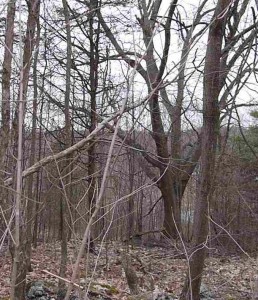 small instrument building business, but I’m realizing more and more that it feels very sterile
small instrument building business, but I’m realizing more and more that it feels very sterile
Of course, this is not the relationship that pipemakers have always had with their wood sources. Before we had access to fancy exotic woods, we used whatever was available. If the only wood around was what was growing next door, that’s what was used. Pipemakers were woodsmen, and knew every type of local tree by sight, and knew how best to season their wood. We’ve lost that relationship with our raw materials largely, but there’s no reason we can’t get some of it back. There are pipemakers, such as Julian Goodacre, who have regained that relationship.
I feel very fortunate to be able to make pipes for folks who are interested in “alternative” woods. Mesquite, osage, plum, apple, apricot, pear, pistachio and hop hornbeam are all great woods for pipes and all grow in the US. That means that woods that grow “next door” (or even on your own property) might be a viable option. For many of us pipers, that’s an exciting possibility.
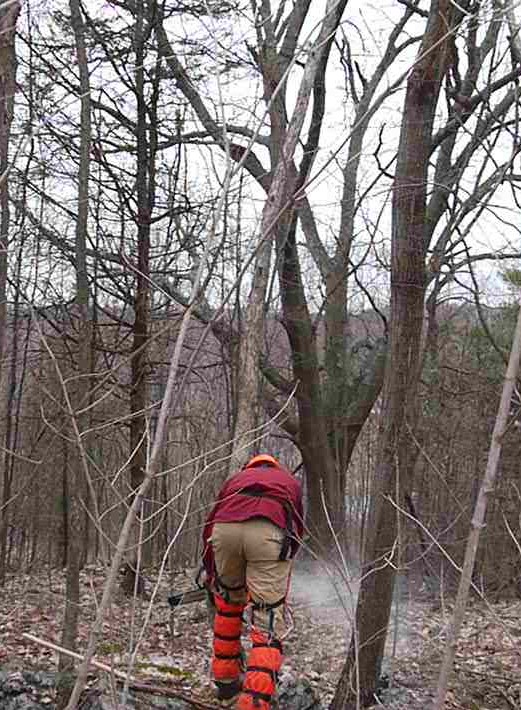 When I was an apprentice uilleann pipe maker, we only used ebony, and I knew that highland pipes were only made from African blackwood (or occasionally cocobolo) so I was fascinated when I first saw that pipe makers like David Quinn and EJ Jones were using “alternative” woods. When I left my apprenticeship and began making my first prototypes of what would later be my smallpipe and Border pipe designs, I used mesquite and osage orange. It was cheaper than trashing ABW, and I quickly found that they produced instruments that sounded great. Now, over the years, I’ve used many woods. The more woods I try, the more I realize that the bias for super dense exotic woods is somewhat silly. I’ve had more cracks and banana chanters (thankfully very few!) from the exotic woods then from the softer “domestic” woods. And I’ve found that while the softer woods do lend a mellowness to the sound, there is little to no lessening of volume.
When I was an apprentice uilleann pipe maker, we only used ebony, and I knew that highland pipes were only made from African blackwood (or occasionally cocobolo) so I was fascinated when I first saw that pipe makers like David Quinn and EJ Jones were using “alternative” woods. When I left my apprenticeship and began making my first prototypes of what would later be my smallpipe and Border pipe designs, I used mesquite and osage orange. It was cheaper than trashing ABW, and I quickly found that they produced instruments that sounded great. Now, over the years, I’ve used many woods. The more woods I try, the more I realize that the bias for super dense exotic woods is somewhat silly. I’ve had more cracks and banana chanters (thankfully very few!) from the exotic woods then from the softer “domestic” woods. And I’ve found that while the softer woods do lend a mellowness to the sound, there is little to no lessening of volume.
Tim’s Hop Hornbeam trees grow just to the right of his driveway. You can see them out the living room window. The Saturday morning I was visiting, we convinced his chainsaw wielding neighbor to come over and cut one down. Tim didn’t want to cut down one of the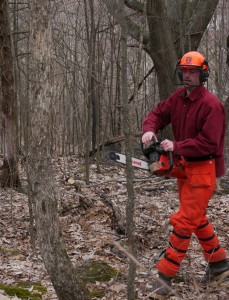 three or four big oldies, so we chose one of the medium sized chaps, maybe nine inches in diameter. A bit smaller then I’d prefer, but I’d had good luck seasoning an apple tree of similar diameter before.
three or four big oldies, so we chose one of the medium sized chaps, maybe nine inches in diameter. A bit smaller then I’d prefer, but I’d had good luck seasoning an apple tree of similar diameter before.
After the tree was on the ground, I walked the length of it, marking the tree by eye into straightish, approximately two foot long sections. Then Mr. Chainsaw cut up the tree along those marks.
Seasoning/curing of wood for musical instruments is a bit of a hot topic, but let’s just say that there are a couple different camps who hold some pretty disparate ideas on the best way to season. Most agree that air drying is the only way to go; they say kiln drying bursts wood’s cell walls which is not a good thing. The prevailing idea seems to be that one should paint/coat the ends of the logs, as wood dries much quicker from the ends then from the sides which causes the cracking (unequal expansion/contraction). Of course another camp says to just leave the ends and let the wood crack, thereby letting the wood do as it will. Whatever is left will be the good stable stuff. Then there are a few camps with some pretty out there ideas who say things like you should stick it at the bottom of a lake for ten years, or bury it in 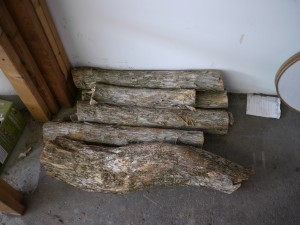 manure (I’ve used woods which have gone through both of these processes!).
manure (I’ve used woods which have gone through both of these processes!).
Tim and I decided that we’d do a bit of simple experimenting ourselves. I took half of the wood and Tim kept half. Tim is keeping all of his logs in his unheated garage, and I am keeping all of my logs in my workshop (heated, thank goodness). Both of us will paint the ends of half of our logs to slow the rate of drying along the ends, leaving half to do as they will. And that’s how it stands now. The only thing left to do is the easiest and hardest part; we have to leave the wood alone for a few years.
Glenn Dreyer, our intrepid APNA editor, and Director of the Connecticut College Arboretum, New London, following my “advice”, has cut down a dogwood tree and will be seasoning it in the same manner that Tim and I are seasoning the Hop Hornbeam. Dogwood is another North Eastern wood that is rumored to work very well for woodwinds.
Living Dogwood tree flowering
Benthamidia (formerly Cornus) florida – “Flowering Dogwood”,
Standing dead in yard.
Dogwood logs
Ends starting to crack already.
I’ll leave you with a promise to keep APNA updated on the progress of the wood and this video from Ben’s recital:

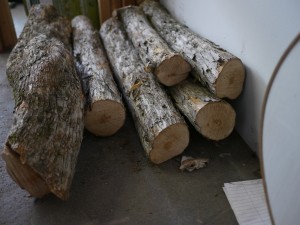
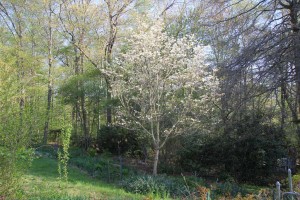
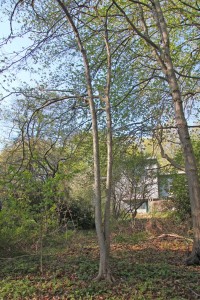
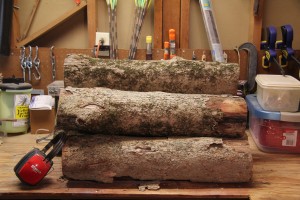
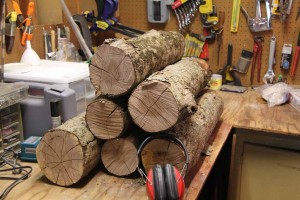
Great article. Since I have started to look at alternative woods for pipes I think about the trees in my neighborhood in a different way. I think it makes some of them nervous.
I worked at an historic trade shop for about a year and we would put up large Elm trunks for wooden wheel hubs. We would bore a hole through the center of the hub from one end to the other and this would prevent checking by allowing more even drying. Don’t know if that would apply here, but it worked for the larger pieces we were working with.
Thanks for the comment John. Yes, boring a hole through wood is another of the “camps” of thought on seasoning, and probably a very sound one. I do this sometimes with wood that I’m uncertain of its dryness.
There are probably as many theories on seasoning wood as there are types of trees!
Great stuff!
Hornbeam in Nova Scotia is also known as iron wood. The local indigenous tribes seasoned the wood by placing it in a fast moving stream for a year. The water displaced the sap and reduced checking during the normal drying out process. It sounds like the bottom of the lake method you mention, but with some local flavour. I have heard the natives used the wood for daggers/ knives. In the ship building area around Bridgewater and Lunenburg, the wood was so dense they used it for hammer heads and I remember seeing one such hammer which only had small indentations in the face after driving several good sized nails… very hard indeed. I have one or to small logs in the back shed which have been there for about 12 years. the wood is checked pretty badly, but there is enough for small pipe drones I think.
Cheers, Barry
I’d love to make a set of drones from wood from Nova Scotia. The stream method is a new one to me, but as you said, similar to the lake method I suppose.
Down my road is a connecting road, “Orchard Rd.” Years ago a host of fruit trees covered it’s length. I noticed an old persimmon tree in someone’s backyard and wondered, since drivers were once made of persimmon wood (and since some revival clubmakers are still doing it!), whether persimmon might make good pipe wood.
Hey Michael,
I’ve not seen one in person, but I have heard of pipes being made from persimmon. It’s definitely on my list of woods to keep an eye out for.
Persimmon is a variety of Ebony I believe (from the same family).